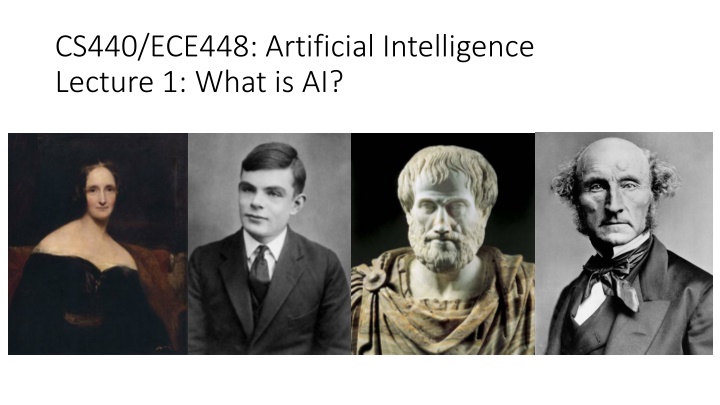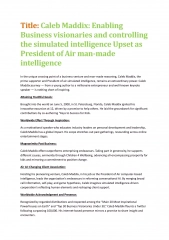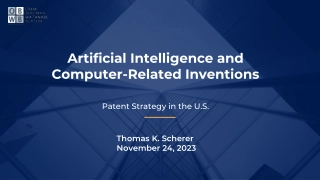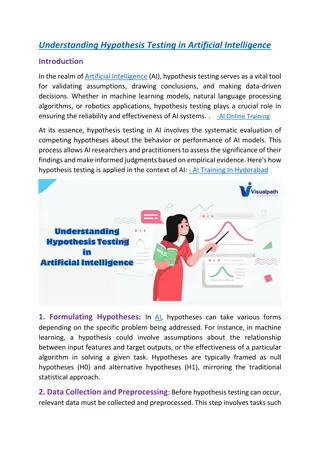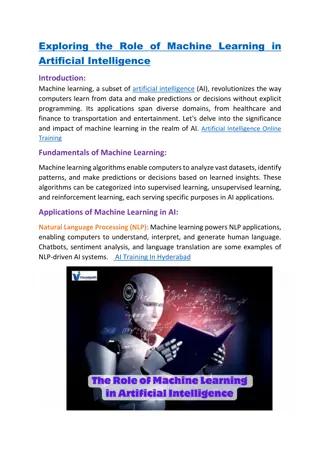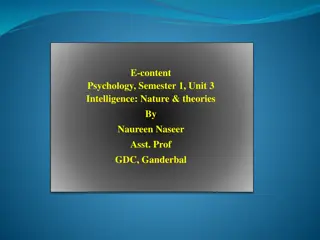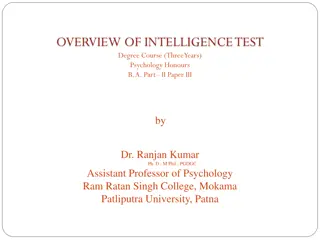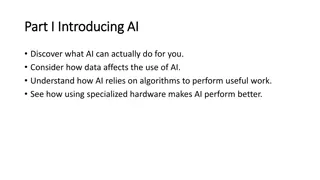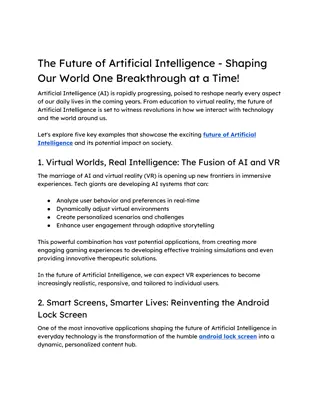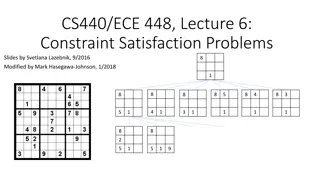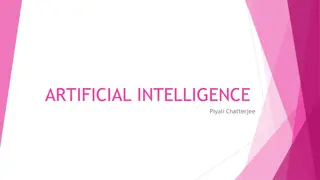CS440/ECE448: Artificial Intelligence
The content covers the syllabus overview, philosophy of AI, thinking and acting like a human, thinking and acting rationally, administrative questions on grading policies, mini-projects, late submissions, and plagiarism. It also provides details on course grading, office hours, Piazza for help, and the importance of originality in work.
Download Presentation

Please find below an Image/Link to download the presentation.
The content on the website is provided AS IS for your information and personal use only. It may not be sold, licensed, or shared on other websites without obtaining consent from the author.If you encounter any issues during the download, it is possible that the publisher has removed the file from their server.
You are allowed to download the files provided on this website for personal or commercial use, subject to the condition that they are used lawfully. All files are the property of their respective owners.
The content on the website is provided AS IS for your information and personal use only. It may not be sold, licensed, or shared on other websites without obtaining consent from the author.
E N D
Presentation Transcript
CS440/ECE448: Artificial Intelligence Lecture 1: What is AI?
CS440/ECE448 Lecture 1: What is AI? 1. Administration: Overview of the Syllabus 2. A two-bit summary of the philosophy of AI 3. Thinking like a Human 4. Acting like a Human 5. Thinking Rationally 6. Acting Rationally
1. Administrative Questions Web page How is this course graded? Policies How can I get help?
Web page http://courses.engr.Illinois.edu/cs440/ http://courses.engr.Illinois.edu/cs440/
How is this course graded? 40%: Exams Mostly from the slides. The page http://courses.engr.Illinois.edu/cs440/lectures.html includes sample problems from the textbook. 60%: MPs (Mini-Projects) Each MP is designed to require about 19 hours of work, including ~14 hours of thinking/ coding/ debugging and ~5 hours of waiting for your computer. Seriously. We really do target 19 hours. You can work in teams of up to 3, only if it helps you. Software management exercise. 40%: Exams Mostly from the slides. The page http://courses.engr.Illinois.edu/cs440/lectures.html includes sample problems from the textbook. 60%: MPs (Mini-Projects) Each MP is designed to require about 19 hours of work, including ~14 hours of thinking/ coding/ debugging and ~5 hours of waiting for your computer. Seriously. We really do target 19 hours. You can work in teams of up to 3, only if it helps you. Software management exercise.
Policies Late MPs: Only if every member of your team has an emergency documented by the emergency dean. If no emergency, penalty is 10% per day. No homework accepted more than 7 days late. DO THE HOMEWORK. Even partly, even 6 days late. If you miss ONE MP, you will probably not pass. Plagiarism Please DO search online to find good ideas. Please LEARN THE IDEAS, don t COPY THE CODE. Graders will read on-line code repos before grading your MP. Late MPs: Only if every member of your team has an emergency documented by the emergency dean. If no emergency, penalty is 10% per day. No homework accepted more than 7 days late. DO THE HOMEWORK. Even partly, even 6 days late. If you miss ONE MP, you will probably not pass. Plagiarism Please DO search online to find good ideas. Please LEARN THE IDEAS, don t COPY THE CODE. Graders will read on-line code repos before grading your MP.
How Can I Get Help? Office Hours: ECEB 5034. Times listed here: https://courses.engr.illinois.edu/ece448/sp2018/homework. html Piazza: https://piazza.com/class/jc8mft43dmb4gu Teaching staff will check piazza at least once/day Fellow students strongly encouraged to give good answers. Extra credit may be given for useful piazza answers. DON T post code on piazza, either for questions or for answers. You can post pseudo-code if you want. Wikipedia etc: Often very useful. See previous slide. Office Hours: ECEB 5034. Times listed here: https://courses.engr.illinois.edu/ece448/sp2018/homework.html Piazza: https://piazza.com/class/jc8mft43dmb4gu Teaching staff will check piazza at least once/day Fellow students strongly encouraged to give good answers. Extra credit may be given for useful piazza answers. DON T post code on piazza, either for questions or for answers. You can post pseudo-code if you want. Wikipedia etc: Often very useful. See previous slide.
What is Artificial Intelligence? Artificial (adj., Wiktionary): Man-made, i.e., constructed by means of skill or specialized art. Intelligence (noun, Wiktionary): Capacity of mind to understand meaning, acquire knowledge, and apply it to practice. Artificial Intelligence (implied by above): capacity of a man-made system to understand, acquire, and apply knowledge.
What is Artificial Intelligence? Candidate definitions from the textbook: 1. Thinking humanly 2. Acting humanly 3. Thinking rationally 4. Acting rationally
3. Thinking like a Human Mary Shelley, author of Frankenstein: The Modern Prometheus; Neuron, showing branching of the dendrites; EEG cap; Cortical connectivity map, computed using diffusion tensor MRI
How many computations/second? Hodgkin-Huxley neuron: Neural computations are binary. Each neuron is either generating an action potential, or not. Action potentials at rates between 1Hz and 1000Hz (1 to 1000 times/second) Each neuron s action potential is communicated to a set of other neurons --- usually 100-1000 other neurons.
Suppose the brain has 100 trillion neurons. How many binary computations per second can the brain perform?
Modern neuroimaging techniques EEG (electro-encephalography) Good temporal resolution: ~1000 samples/second Poor spatial resolution: ~128 channels for the whole brain. EEG activity therefore always reflects the summation of the synchronous activity of thousands or millions of neurons that have similar spatial orientation. fMRI (functional magnetic resonance imaginge) Better spatial resolution: ~1mm/voxel, ~2000 voxels/brain (vs. 100 trillion neurons) Poor temporal resolution: ~2 seconds/sample ECOG (electrocorticography) Spatial resolution of fMRI + temporal resolution of EEG Only for the part of the brain that has been surgically revealed, for a living thinking human.
The best supercomputers perform far more computations/second than the human brain. If that s true, why have we not yet duplicated a human brain?
4. Acting like a Human Schematic of the Turing test; Alan Turing
The Turing Test Alan Turing, Intelligent Machinery, 1947: It is not difficult to devise a paper machine which will play a not very bad game of chess. Now get three men as subjects for the experiment. A, B and C. A and C are to be rather poor chess players, B is the operator who works the paper machine. Two rooms are used with some arrangement for communicating moves, and a game is played between C and either A or the paper machine. C may find it quite difficult to tell which he is playing. We now ask the question, What will happen when a machine takes the part of A in this game? Will the interrogator decide wrongly as often when the game is played like this as he does when the game is played between a man and a woman? These questions replace our original, Can machines think?
What capabilities would a computer need to have to pass the Turing Test? Natural language processing Knowledge representation Automated reasoning Machine learning Turing predicted that by the year 2000, machines would be able to fool 30% of human judges for five minutes A. Turing, Computing machinery and intelligence, Mind 59, pp. 433-460, 1950
Whats wrong with the Turing test? Variability in protocols, judges Success depends on deception! Chatbots can do well using cheap tricks First example: ELIZA (1966) Javascript implementation of ELIZA
A better Turing test? Winograd schema: Multiple choice questions that can be easily answered by people but cannot be answered by computers using cheap tricks The trophy would not fit in the brown suitcase because it was so small. What was so small? The trophy The brown suitcase H. Levesque, On our best behaviour, IJCAI 2013 http://www.newyorker.com/online/blogs/elements/2013/08/why-cant-my- computer-understand-me.html
A better Turing test? Winograd schema: Multiple choice questions that can be easily answered by people but cannot be answered by computers using cheap tricks The trophy would not fit in the brown suitcase because it was so large. What was so large? The trophy The brown suitcase H. Levesque, On our best behaviour, IJCAI 2013 http://www.newyorker.com/online/blogs/elements/2013/08/why-cant-my- computer-understand-me.html
Winograd schema Advantages over standard Turing test Test can be administered and graded by machine Scoring of the test does not depend on human subjectivity Machine does not require ability to generate English sentences Questions cannot be evaded using verbal tricks Questions can be made Google-proof (at least for now ) Winograd schema challenge Held at IJCAI conference in July 2016 Six entries, best system got 58% of 60 questions correct (humans get 90% correct)
Sample questions In what way can it be said that a machine that passes the Turing test is intelligent? In what way can it be said that a machine that passes the Turing test is _not_ intelligent? Give a few reasons why the Winograd schema is a better test of intelligence than the Turing test
AI definition 3: Thinking rationally Aristotle, 384-322 BC
AI definition 3: Thinking rationally Idealized or right way of thinking Logic: patterns of argument that always yield correct conclusions when supplied with correct premises Socrates is a man; all men are mortal; therefore Socrates is mortal. Logicist approach to AI: describe problem in formal logical notation and apply general deduction procedures to solve it
Syllogism Syllogism = a logical argument that applies deductive reasonining to arrive at a conclusion based on two or more propositions that are asserted to be true. Example Problem (you should know this from binary logic classes): Given: ? ? Given: ? ? Given: ? is false Which of the following are true? a. ? is true b. ? is false c. ? is true d. ? is false
Successes of Logicist Approach: Expert Systems Expert system = (knowledge base) + (logical rules) Knowledge base = database of examples Logical rules = easy to deduce from examples, and easy to verify by asking human judges Combination of the two: able to analyze never-before-seen examples of complicated problems, and generate an answer that is often (but not always) correct Expert systems = commercial success in the 1970s Radiology, geology, materials science expert systems advised their human users Dating services (match users based on hobbies, etc.)
Successes of Logicist Approach: Fuzzy Logic Logic operations Category Labels (cold, warm, hot) Real numbers (e.g.,room temperature) If cold then turn up the thermostat. By fullofstars - original (gif): Image:Warm fuzzy logic member function.gif, CC BY-SA 3.0, https://commons.wikimedia.org/w/index.php?c urid=2870420 If hot then turn down the thermostat. Real numbers (e.g., thermostat temperature) Category Labels (up, down)
Successes of Logicist Approach: Fuzzy Logic Example: speed control system of the https://en.wikipedia.org/wiki/Sendai_Subway_Namb oku_Line. This system (developed by Hitachi) accounts for the relative smoothness of the starts and stops when compared to other trains, and is 10% more energy efficient than human-controlled acceleration.
Failures of Logicist Approach: Fragility, and the AI Winter Expert systems/fuzzy logic work if the number of rules you have to program is small and finite. The law of the out-of-vocabulary word: No matter how many words are in your dictionary, there are words you missed. Empirical proof: Hasegawa-Johnson, Elmahdy & Mustafawi, Arabic Speech and Language Technology, 2017 Implication: no matter how carefully you design the rules for your expert system, there will be real-world situations that it doesn t know how to handle. This is a well-known problem with expert systems, called fragility Corporations and governments reacted to fragility by reducing funding of AI, from about 1966-2009. This was called the AI Winter.
Failures of Logicist Approach: Humans dont think logically. https://dilbert.com/strip/2019-01-08
AI definition 4: Acting rationally John Stuart Mill, 1806-1873
AI definition 4: Acting rationally A rational agent acts to optimally achieve its goals Goals are application-dependent and are expressed in terms of the utility of outcomes Being rational means maximizing your (expected) utility This definition of rationality only concerns the decisions/actions that are made, not the cognitive process behind them An unexpected step: rational agent theory was originally developed in the field of economics Norvik and Russell: most people think Economists study money. Economists think that what they study is the behavior of rational actors seeking to maximize their own happiness.
Utility maximization formulation: Advantages Generality: goes beyond explicit reasoning, and even human cognition altogether Practicality: can be adapted to many real-world problems. Avoids philosophy and psychology. Solvability: Amenable to good scientific and engineering methodology For all of these reasons, this course will usually adopt this definition: An artificial intelligence is a machine that acts rationally (reasons out a plan of action) in order to maximize some measure of utility (a measure of how good is the resulting situation)
Utility maximization formulation: Disadvantages Practical disadvantages: can a machine act rationally in order to achieve a desirable outcome? Why or why not? * Some problems only have vacuous solutions Finite resources (compute time, memory) Biased training data: real world is not what expected Real world randomness/unpredictability Programmer might not know how to calculate the answer Theoretical disadvantages: should a machine act rationally in order to achieve a desirable outcome? Why or why not? Not if it s acting against human interests Special circumstances, e.g., conflicting goals; subvert the usual rules to achieve an outcome that s uniquely desirable right now People are not rational; conversational agent might not be always rational either
What is Artificial Intelligence? 1. Thinking humanly 2. Acting humanly 3. Thinking rationally 4. Acting rationally
